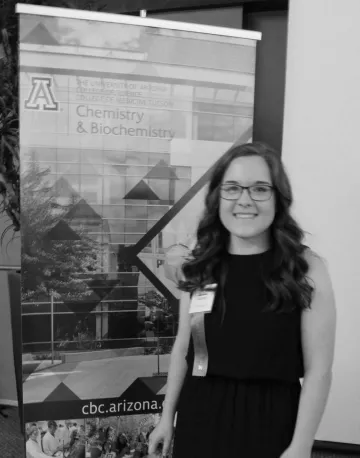
This past summer, I worked in Dr. Rebecca Mosher’s plant science lab studying the evolution of protein components within the plant silencing pathway of small RNA-directed DNA methylation (RdDM) pathway. RdDM involves cooperative interactions between plant specific proteins called RNA polymerases IV and V, which evolved early in land plant evolution. Recently published work from Dr. Mosher’s laboratory provides evidence for the evolution of a novel sixth RNA polymerase protein with a distinct function in the grass family, Poaceae. I actively investigated protein-protein interactions between the proteins involved in RdDM to determine the evolutionary significance of the emergence of a sixth distinct polymerase in grasses.
This fall, I moved back into Dr. Jacob Schwartz’s biochemistry lab to continue investigating the native role of RNA-binding protein Fused in Sarcoma (FUS) in transcription and the development of amyotrophic lateral sclerosis (ALS). Amyotrophic Lateral Sclerosis (ALS) is a neurodegenerative disease that causes the breakdown of upper and lower motor neurons, resulting in eventual paralysis and death by respiratory failure. Numerous genetic mutations have been closely associated with or linked to the development of ALS; several of these mutations have been discovered in RNA-binding proteins. Fused in Sarcoma (FUS) is a nuclear RNA-binding protein that has been found to associate with the C-terminal domain (CTD) of human RNA polymerase II (RNAP2) and other transcriptional machinery. In the cell nucleus, RNA stimulates FUS to oligomerize with itself to form fibrous assemblies that interact with proteins such as RNAP2 to regulate transcription. In diseased cells, FUS is found in large toxic aggregates that have lost the ability to assemble and disassemble rapidly, preventing them from functioning as effective regulators of transcription. To completely understand the role of FUS in the development of ALS, I have been exploring the wildtype function of the protein as a regulator of transcription.
My ability to work in a research lab is made possible by the University of Arizona’s Undergraduate Biology Research Program (UBRP). UBRP enhances undergraduate education by partnering with the research resources of the University of Arizona to provide opportunities for students to participate in mentored, self-directed work which contributes to the fund of new knowledge. Students' projects involve inquiry, design, investigation, research, scholarship, discovery, and the presentation of experimental results. UBRP not only provides me with the opportunity to conduct research, but also fosters an accepting and inclusive environment for students in the program. This summer, I had the opportunity to visit Kartchner Caverns, volunteer at the Community Food Bank of Southern Arizona, and tour the Kitt Peak National Observatory.






